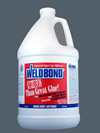
Wednesday, 20 May 2009
Thursday, 7 May 2009
PVA Sizing/Ground Recipe for Oil or Acrylic

Why make your own sizing? Three reasons. It's fun. It's ready when you are. It's cheap. (I know, I know, it sounds like the perfect date.)
Equipment and Supplies
- 5 to 10 lb. bag of calcium carbonate (a.k.a. whiting). Should cost about $5-10. Whiting is available in bulk at pottery supply stores like the "Sounding Stone" in Winnipeg.
- 1 gallon (4 l.) jug of PVA white (not yellow) carpenters' glue like Weldbond or Lepages. (~$25)
- Electric drill with paint mixer propeller or an electric hand mixer with two beaters or even a kitchen whisk (hint: don't use these for food prep afterward).
- Two-10 oz. empty Campbell's Soup cans. One for wets (water, glue pigment) one for dry (whiting).
- A 1 gallon or slightly larger pail with resealable lid (I use an clean, empty dishwasher-detergent pail from SuperValue).
Instructions
Using the empty soup cans mix the following into the pail:
- 3 Parts PVA Glue to
- 3 (to 6) Parts Water to
- 9 (to 12) Parts "Whiting" and
- 1 (to 2) Parts Titanium White pigment (optional as the chalk will makes it white also) I use Rheotech it's good and it's cheap.
Start by mixing the water and glue together with your drill-mixer. Put in the whiting three cans at a time mixing constantly until you reach 9 cans. Mix for a while and then let the mixture slake (rest) in the pot for 5 or 10 minutes. Mix again to make sure all the lumps have broken up and add the titanium white. Keep mixing. Let it slake once or twice more. Test the mixture on an old board or canvas. This is a "stock" solution but if it's too thick (read: too gluey) try adding more water. Too watery? Try adding more whiting. Different glues may have different results. When applying to board I would thin your "stock" solution with about half water (or more) for the first two coats.
Build up the layers from thinnest to thickest sanding lightly between coats. Three to five coats should be about right. PVA dries quickly between coats but should be left for at least 24 hours to cure properly before applying gesso or painting.
When you're brushing on the latter "thick" coats -- if you find the brush marks annoy you try using a clean damp to wet trim brush to "brush out" or "knock down" the marks with a perpendicular stroke.
Makes about a gallon of sizing per batch. A gallon of glue will make three or four batches though.
Subscribe to:
Posts (Atom)
